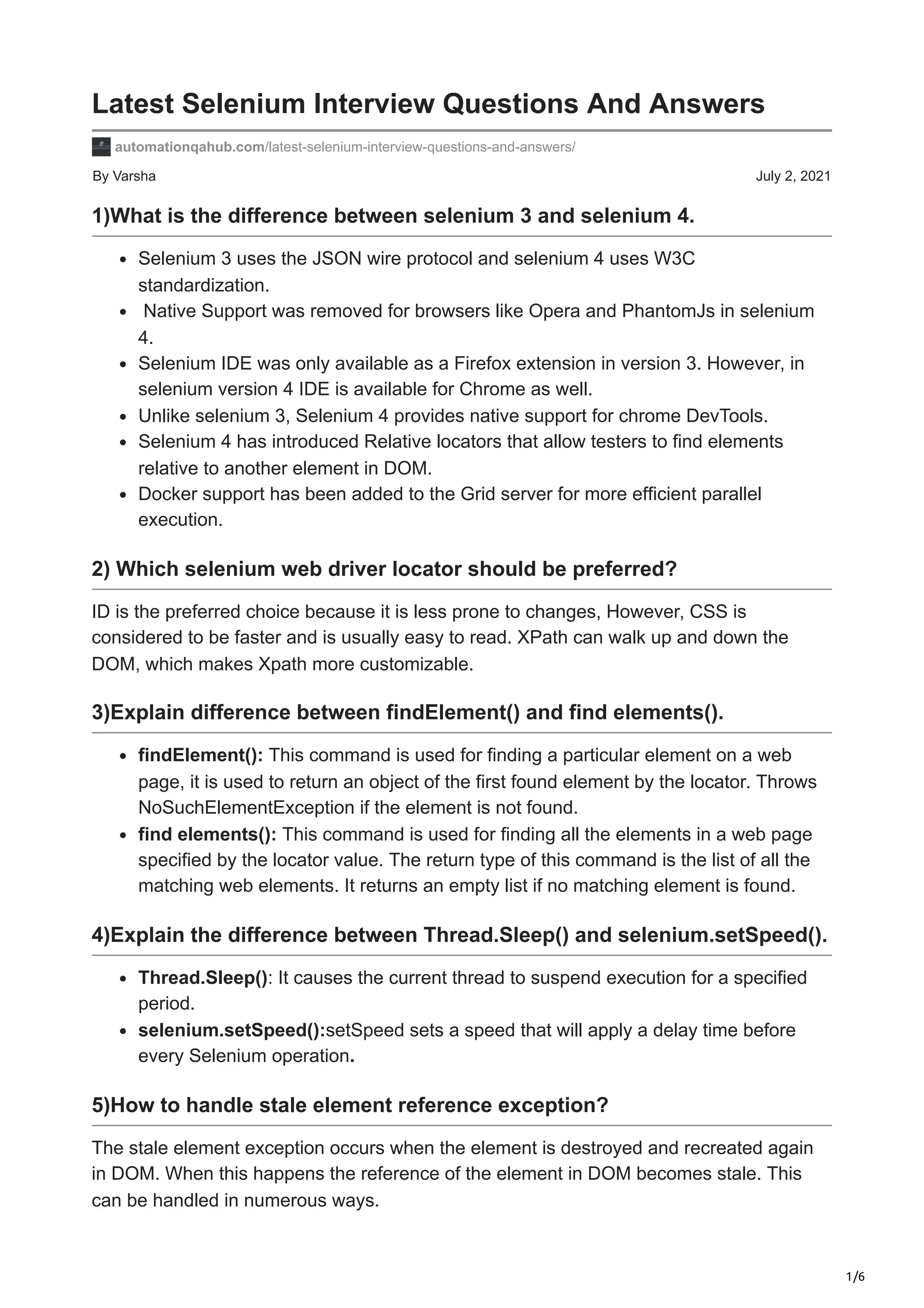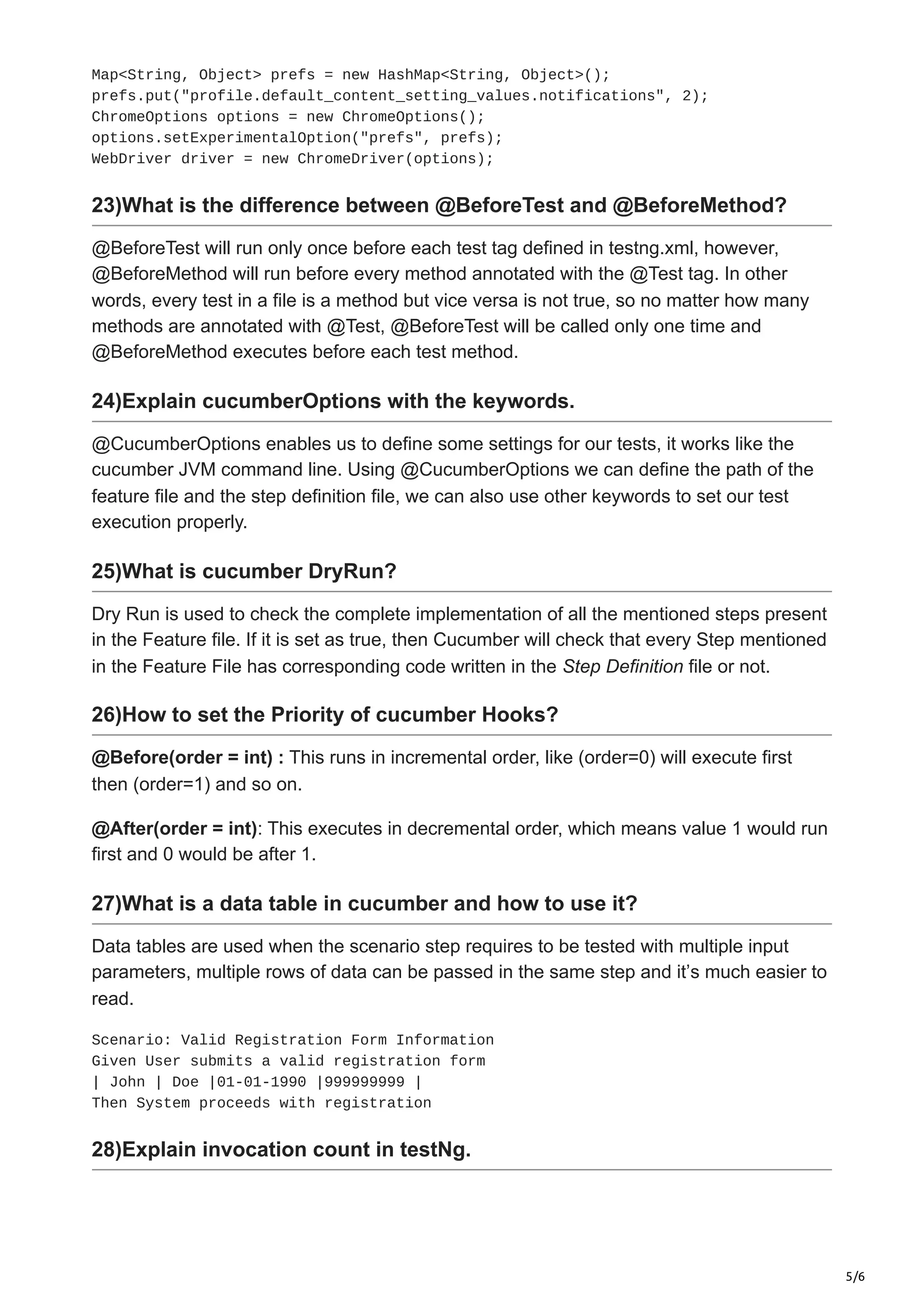The document provides a comprehensive guide on Selenium interview questions, covering differences between Selenium 3 and 4, preferred locator strategies, methods for handling exceptions, and browser interactions. It also explains TestNG annotations, Cucumber testing methods, and various ways to enhance test automation strategies. Key topics include the Page Object Model, handling stale elements, and differences between WebDriver commands.

![2/6 1)Refresh the page and try to locate the stale element again. 2) Use Explicit wait to ignore the stale element exception. 3) Try to access the element several times in the loop(Usually not recommended.) 6)How many types of WebDriver APIs are available in selenium. Chrome, Geko Driver, Chromium, Edge. 7)How to open the browser in incognito mode. This can be done by using ChromeOptions class to customize the chrome driver session and adding the argument as “incognito”. ChromeOptions options = new ChromeOptions(); options.addArguments(“– incognito”); DesiredCapabilities capabilities = DesiredCapabilities.chrome(); capabilities.setCapability(ChromeOptions.CAPABILITY, options); 8)How to handle file upload in selenium. File upload can be done in 3 ways: By using Robot class. By using sendkeys. By using AutoIt. 9)How many parameters are selenium required? Selenium requires four parameters: Host Port Number Browser URL 10)How to retrieve css properties of an element. driver.findElement(By.id(“id“)).getCssValue(“name of css attribute”); driver.findElement(By.id(“id“)).getCssValue(“font-size”); 11)How can you use the Recovery Scenario in Selenium WebDriver? By using “Try Catch Block” within Selenium WebDriver Java tests. 12)How To Highlight Element Using Selenium WebDriver? Use Javascript Executor interface: JavascriptExecutor js = (JavascriptExecutor) driver; js.executeScript("arguments[0].setAttribute('style', 'background: yellow; border: 2px solid red;');", element);](https://image.slidesharecdn.com/automationqahub-220924064739-85536b70/75/Latest-Selenium-Interview-Questions-And-Answers-pdf-2-2048.jpg)
![3/6 13)Explain a few advantages of the Page Object Model. Readable and Maintainable code. Less and optimized code. Low redundancy. 14)List some Commonly used interfaces of selenium web driver. WebDriver TakesScreenshot JavascriptExecutor WebElement SearchContext 15)What is the difference between @FindAll and @Findbys. @FindBys: When the required WebElement objects need to match all of the given criteria use @FindBys annotation. @FindBys( { @FindBy(className = "class1") @FindBy(className = "class2") } ) private List<WebElement> ele //elements With Both_class1 AND class2; @FindAll: When required WebElement objects need to match at least one of the given criteria use the @FindAll annotation. @FindAll({ @FindBy(className = "class1") @FindBy(className = "class2") }) private List<WebElement> ele //elements With Either_class1 OR class2 ; 16)How to Click on a web element if the selenium click() command is not working. There are multiple ways provided by the selenium web driver to perform click operations. You can use either Action class or can leverage javascript executor. a) Javascript executor is an interface provided by selenium to run javascript through selenium web driver. import org.openqa.selenium.JavascriptExecutor; public void clickThruJS(WebElement element) { JavascriptExecutor executor = (JavascriptExecutor) Driver; executor.executeScript(“arguments[0].click();”, element); }](https://image.slidesharecdn.com/automationqahub-220924064739-85536b70/75/Latest-Selenium-Interview-Questions-And-Answers-pdf-3-2048.jpg)


